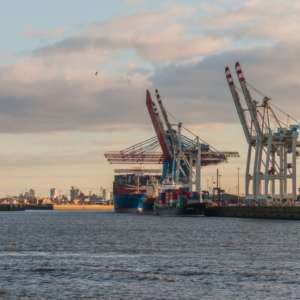In April 2018, IBM and DHL released a joint report proclaiming that the time is ripe for logistics and supply chain management to embrace artificial intelligence (AI). “Furthermore,” the paper warns, “companies deciding not to adopt AI run the risk of obsolescence in the long term, as competitors seize and effectively use AI in their business today.” It’s a bit bewildering, since for years we were told that the AI revolution was just over the horizon, and now we are told that it has already happened, and we’d better get on board or risk being left behind. In truth, artificial intelligence has already infiltrated our lives, every time Google tailors a search result specifically to our interests, Netflix suggests a movie, or Facebook correctly identifies our identities in a photograph. There is no disputing that AI is poised to tackle some of logistics’ most fundamental problems, offering insights that can dramatically improve productivity and profits, but before the industry takes a giant leap into a more automated future, it’s essential to acknowledge and plan for its inevitable victims.
Any discussion of artificial intelligence must begin with a working definition of what AI actually is, since the media and popular culture often lead people to imagine a (frequently menacing) superintelligence operating with minimal human oversight. While this possibility merits some concern, when we discuss AI, we’re generally referring to systems that utilize machine learning, which has rapidly matured in recent years due to advances in computer hardware and software, as well as the accessibility of big data on which it can “learn.”
 Image courtesy IBM/DHL
Image courtesy IBM/DHL
The newfound capabilities of AI to process huge amounts of heterogeneous and fast-moving data mean that there are clear logistical applications for it. The IBM/DHL white paper posits numerous uses for AI-enabled technology that seem irresistible in their ability to unlock new efficiencies. Among these are automated and accelerated customs brokerage to handle the huge amount of paperwork (a single packing slip on a cross-border return to Canada can run over 400 pages) intrinsic to international shipping in ways that are streamlined and resistant to either human error or malfeasance. This single application could save freight forwarders an enormous amount of money both in terms of demurrage fees and staff time spent on tedious, repetitive tasks. Beyond simply handling data, AI is poised to make insights about supply chains that are beyond the scope of human abilities. The business of logistics has always been a Herculean effort to anticipate supply chain needs based on variables ranging from consumer demand, to global politics, to the weather. AI could revolutionize this with predictive analytics, some applications of which are already in use. In its report, DHL claims to have developed “a machine learning-based tool to predict air freight transit time delays,” and when lane activity is expected to rise or fall up to a week in advance. Logistics professionals have long relied on historical data to determine supply and demand based on seasonality of a product, but AI could conceivably scour social media and YouTube to determine what products are about to “go viral” and give manufacturers a head start (fidget spinners, anyone?).
These insights are not confined to the digital world. AI’s sensory awareness continues to multiply, giving it more physical applications, and the possibilities for automated inspections in logistics are beginning to be felt. In GE factories, AI-enabled sensors have predicted equipment defects and failures ahead of time, reducing unplanned downtime on the shop floor by 20 percent. Cameras equipped with IBM’s Watson were mounted above a train track to search for wagon defects, and quickly achieved an accuracy rating of over 90 percent. Retail stores are already experimenting with AI-powered robots that roam the aisles, scanning inventory levels. At a time when warehouse space is at a premium and retail depends on a low-inventory model, this kind of data could be invaluable, so it’s no wonder the industry’s major players are eager to apply AI solutions to their problems. In April, Hong Kong-based OOCL announced a partnership with Microsoft to use AI to improve efficiencies, a collaboration OOCL says will save it $10 million a year in operating costs.
The promise of AI to solve logistical problems faster and more cost-effectively than humans is tantalizing, and we’ve barely scratched the surface of its potential uses, but for many this promise is tempered by a sense of unease, that we have not fully considered the repercussions of entering this brave new world. AI’s proponents are quick to gloss over concerns about its risks as the confusion that has accompanied every new technology since the industrial revolution, but artificial intelligence is profoundly different from any innovation that has come before it.
One does not need to imagine a Hollywood-style doomsday scenario to envision at least two major problems that stand to arise from widespread adoption of AI. The first is job loss. A study by the McKinsey Global Institute estimates that “almost half of all work activities have the potential to be automated by adapting currently proven technology.” AI evangelists counter this alarming statistic by saying that AI and automation will render some careers obsolete, but create others in repairing automated machines (presumably until they learn to repair themselves). The DHL/IBM report goes so far as to claim that, “As AI begins to relieve humans of much routine and lower order work, higher-order work that requires caring and empathy will become more important.” This often-repeated bromide carries with it many troubling assumptions about what constitutes “higher-order work,” and fundamentally dodges the question of how our society will value and employ people replaced by AI. This question is about to become an urgent issue in logistics with the advent of driverless trucks. The technology to power driverless trucks is advancing rapidly, and while the companies developing it attempt to frame it as “driver-assisted” or “driver-augmented,” no one should be seriously fooled that trucking will not replace human drivers the moment it is safe and affordable to do so. There are 3.5 million truck drivers in the United States. What will happen to them?
The other question we must ask about artificial intelligence is how comfortable we are with accepting the conclusions offered by programs with computational power that outstrips our own. According to a Transport Topics article on AI in digital security, “The self-learning aspect of the technology is so advanced…that even the programmers who create thinking AI often have no idea after a while what the AI knows, how it got from here to there, and what underlying logic it’s currently using to define and neutralize threats.” Logistics companies that use AI’s predictive analytics to plan their decisions will be trusting a technology that may not be able to explain its insights, and more worryingly, what values inform them. In such a world, to quote Henry Kissinger’s warning in The Atlantic, “Information threatens to overwhelm wisdom.”
If these concerns sound esoteric, that’s because, for the moment, they are. But that is precisely why the time is now to question AI, before its higher-order functionalities infiltrate our industry and our lives, as they have already begun to do in the consumer sphere. Artificial intelligence is being developed by a rarefied group of programmers, funded by corporate and governmental interests, but it will affect all of us. It is possible to imagine a world in which AI allows us to maximize our planetary resources and our human potential, but the only way to work toward that vision of the future, and avoid a much darker one, is with intentionality and a clear sense of our own priorities.



